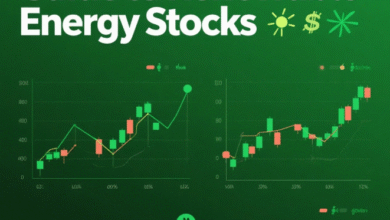Stock Market Trends: How to Analyze Patterns, Key Indicators, and Make Smarter Investments
Advertisement
Every time I check the news, I see headlines about the stock market soaring or tumbling. Market trends shape not only the financial world but also the decisions I make about my investments. Understanding these trends helps me navigate the ups and downs with more confidence.
I know that stock market trends aren’t just about numbers on a screen. They reflect shifts in the economy, global events, and even investor emotions. By keeping an eye on these patterns, I can spot opportunities and avoid common pitfalls. Whether I’m a seasoned investor or just starting, staying informed about market trends is crucial to making smarter investment decisions.
Understanding Stock Market Trends
Patterns in stock market trends reveal shifts in market direction over specific periods. I observe three primary types: uptrends, downtrends, and sideways trends. Uptrends occur when prices move consistently higher, as shown in the S&P 500’s 2021 performance. Downtrends occur when stock values decline over time, as seen during the 2008 financial crisis. Sideways trends develop when prices fluctuate within a limited range, like in many sectors during 2015.
Indicators highlight these trends. I analyze moving averages, such as 50-day and 200-day lines, to smooth out price data and signal direction. Relative strength index (RSI) values above 70 often indicate overbought conditions, while values below 30 may reveal oversold scenarios. Volume spikes frequently confirm the strength of a trend, with increased volume supporting sustained movement.
I rely on both technical and fundamental analysis to interpret stock market trends. Technical analysis focuses on chart patterns and indicators, while fundamental analysis examines economic factors, earnings, and interest rates. Together, these approaches provide a deeper view of why trends emerge and how long they could last.
Accurate trend recognition enables me to adjust my investment strategy, capitalize on emerging opportunities, and anticipate market reversals. By comparing historical patterns and monitoring real-time indicators, I improve my ability to navigate changing market conditions.
Key Factors Influencing Stock Market Trends

Stock market trends reflect broad forces that move prices. Understanding these factors enables me to anticipate changes and make informed investment decisions.
Economic Indicators
Economic indicators signal the direction of the market. I analyze key measures, including GDP growth, unemployment rates, inflation data, and corporate earnings reports, to gauge market strength. For example, rising GDP figures and strong quarterly earnings often trigger sustained uptrends across major indices, while higher unemployment rates or unexpected inflation figures can prompt abrupt downturns. Accurate forecasts from sources such as the Bureau of Economic Analysis or the U.S. Department of Labor help clarify market reactions to economic shifts.
Market Sentiment
Market sentiment shapes short-term price movements. I track investor sentiment through tools such as the CNN Fear & Greed Index, the American Association of Individual Investors (AAII) Sentiment Survey, and media headlines. Positive sentiment usually drives stronger buying, as seen during tech rallies of 2020, while negative sentiment can trigger sudden sell-offs, such as those in March 2020 at the onset of the COVID-19 pandemic. Changes in sentiment often precede major trend reversals.
Global Events
Global events create market volatility and rapid shifts in trends. I monitor central bank policy decisions, geopolitical conflicts, and natural disasters for immediate impact signals. For instance, the Federal Reserve’s interest rate adjustments often influence US stock indices and global equity markets. Other major events, such as Brexit or the Russia-Ukraine conflict, have triggered sharp movements in international markets as investors adjust their positions in response to increased risk. Real-time news sources and government statements offer context for these sudden shifts.
Types of Stock Market Trends
Stock market trends refer to the price movements over time. I track these movements to identify bullish, bearish, and sideways patterns that shape investment strategies.
Bullish Trends
Bullish trends signal rising stock prices across the market. I recognize these during periods like the S&P 500’s record highs from late 2020 to 2021. Key indicators include sustained upward movement in major indices, higher highs, and higher lows confirmed by increased trading volume. Moving averages trending upwards and RSI values above 60 also reinforce bullish sentiment. Economic expansion phases and positive earnings often drive and sustain bullish rallies.
Bearish Trends
Consistent declines in stock prices characterize bearish trends. I identify these patterns during events such as the 2008 financial crisis or the 2022 Q2 market selloff. Characterized by lower lows and lower highs, bearish trends often coincide with negative economic indicators, such as rising unemployment and shrinking GDP. Key technical signals include falling moving averages, declining volume on rallies, and RSI below 40. Financial crises, recession fears, or global uncertainty typically trigger sustained bearish moves.
Sideways Trends
Sideways trends show little net change, with prices fluctuating between support and resistance levels. I observe these trends most frequently in consolidation phases, as seen in the Nasdaq during early 2015. Indicators such as horizontal moving averages and the RSI hovering between 40 and 60 suggest a lack of directional momentum. Sideways patterns often follow major uptrends or downtrends while investors await new economic data or policy signals. These periods present opportunities for range-bound trading rather than long-term investments.
Tools and Techniques for Analyzing Stock Market Trends
Tools and techniques for stock market trend analysis enhance my ability to interpret price movements and spot investment opportunities. By combining technical and fundamental approaches, I create a more precise understanding of market shifts.
Technical Analysis
Technical analysis utilizes price charts, volume data, and statistical indicators to assess the direction of the stock market. I rely on moving averages, such as the 50-day and 200-day simple moving averages, to identify ongoing trends; crossing of these lines often signals potential reversals or momentum shifts. Oscillators, such as the Relative Strength Index (RSI) and Moving Average Convergence Divergence (MACD), measure momentum and help me identify overbought or oversold conditions. Volume analysis confirms trend strength, as rising prices accompanied by increasing volume typically suggest the sustainability of the uptrend. Chart patterns—such as head and shoulders, double tops, and triangles—provide signals for the continuation or reversal of current trends.
Fundamental Analysis
Fundamental analysis evaluates the underlying financial health and growth prospects of companies to determine their market value. I examine earnings reports, revenue growth, profit margins, and valuation ratios, such as Price-to-Earnings (P/E) and Price-to-Book (P/B), for companies in trending sectors. Macro indicators, including GDP growth, inflation rates, and unemployment levels, signal broader economic momentum; these guide me in aligning investment timing with probable market cycles. News about management changes, mergers, regulatory shifts, or industry disruption factors also influences stock performance. By integrating fundamental data, I match market price movements with real economic conditions to refine my trend analysis.
Recent Developments in Stock Market Trends
Major indices, including the S&P 500, Nasdaq, and Dow Jones Industrial Average, recorded new highs in Q1 2024, following stronger-than-expected corporate earnings and resilient US economic data. I observed that technology stocks, such as Nvidia, Microsoft, and Meta Platforms, drove a significant portion of this growth due to advancements in artificial intelligence (AI) and cloud computing.
Market volatility increased during March and April 2024, driven by continued inflationary pressure and uncertainty surrounding the Federal Reserve’s monetary policy. I observed that defensive sectors, such as utilities and consumer staples, attracted increased investor flows when risk appetite weakened.
Global events, including renewed tensions in the Middle East and trade discussions between the US and China, impacted market trends. I tracked how oil prices spiked temporarily, influencing energy sector returns and causing short-term fluctuations in the index.
Retail trading activity surged 18% in early 2024, according to Bloomberg, driven by emerging investment platforms and increased social media participation. I found this shift contributed to higher intraday volatility and rapid price swings in popular stocks.
Sustainable investing gained momentum in recent months, with ESG-focused funds reporting $5.3 billion in new inflows for Q1 2024 (Morningstar). I noted that companies with strong environmental, social, and governance performance outperformed sector averages, boosting their visibility in relevant indices.
| Key Recent Developments | Example Entities / Data | Impact Vector |
|---|---|---|
| Record major index highs | S&P 500, Nasdaq, Dow | Technology outperformance |
| Heightened volatility | March-April 2024, inflation, Fed | Rotation to defensive sectors |
| Geopolitical and global market events | Middle East tensions, US-China trade | Energy sector sensitivity |
| Retail trading surge | 18% rise, Bloomberg, social platforms | Increased intraday volatility |
| ESG investment momentum | $5.3B inflows, Morningstar | ESG stocks outperformed benchmarks |
Recent stock market trends continue to reflect a mix of economic resilience, sector rotation, elevated volatility, and evolving investor priorities, including sustainable investing. I monitor these combined vectors to adjust my approach and inform my market outlook.
Conclusion
Staying ahead in the stock market means staying attuned to evolving trends and adapting quickly. I always remind myself that no single approach guarantees success, so flexibility is key when market conditions shift.
By tracking reliable indicators and staying informed about global events, I can make more confident choices with my investments. The stock market will always present new challenges, but with the right tools and mindset, I’m better equipped to navigate its ups and downs.
Frequently Asked Questions
What are stock market trends?
Stock market trends refer to the general direction in which stock prices move over a specified period. They can be classified as uptrends (prices rise), downtrends (prices fall), or sideways trends (prices move within a range).
Why is it important to understand stock market trends?
Understanding stock market trends helps investors make informed decisions, identify potential opportunities, and avoid common pitfalls. It enables both new and experienced investors to time their trades better and manage risk.
What factors influence stock market trends?
Stock market trends are influenced by economic indicators (like GDP growth and unemployment), market sentiment, and global events such as government policies, geopolitical tensions, or central bank decisions.
How can I identify different types of trends in the stock market?
You can identify trends by analyzing price movements and identifying patterns of higher highs and higher lows (an uptrend), lower highs and lower lows (a downtrend), or stable prices within a range (a sideways trend).
What tools are most useful for analyzing trends?
Common tools include moving averages, the Relative Strength Index (RSI), the Moving Average Convergence Divergence (MACD), and volume analysis. These help confirm the strength and direction of a trend.
What is the difference between technical and fundamental analysis?
Technical analysis utilizes price charts and indicators to forecast future price movements, whereas fundamental analysis concentrates on a company’s financial health, earnings, and broader economic conditions to assess stock value.
Can global events affect stock market trends?
Yes, global events such as geopolitical conflicts, trade negotiations, or changes in monetary policy can cause market volatility and directly impact stock prices.
What are bullish, bearish, and sideways trends?
A bullish trend means stock prices are generally rising, a bearish trend indicates falling prices, and a sideways trend occurs when prices fluctuate within a stable range.
How do I use moving averages in trend analysis?
Moving averages smooth out price data to help you spot the overall direction of a trend. A rising moving average suggests an uptrend, while a falling one indicates a downtrend.
Why should investors monitor both technical and fundamental indicators?
Combining both types of analysis provides a more comprehensive view of the market, enabling investors to make informed decisions by considering both price trends and underlying business conditions.










